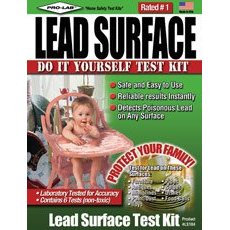 When I first learned about lead in children’s lunch boxes, I rushed to the hardware store to buy my own Home Lead Test Kit. I was concerned about my daughter’s commercial character backpack (which thankfully we no longer have), and we conducted our own Eco Child’s Play lead testing experiment. The results were negative, but now, I have learned that home lead test kits may not be accurate, thus neither was our experiment’s results reliable.
When I first learned about lead in children’s lunch boxes, I rushed to the hardware store to buy my own Home Lead Test Kit. I was concerned about my daughter’s commercial character backpack (which thankfully we no longer have), and we conducted our own Eco Child’s Play lead testing experiment. The results were negative, but now, I have learned that home lead test kits may not be accurate, thus neither was our experiment’s results reliable.
According to Grist, home lead test kits are not reliable for children’s toys: “The Consumer Product Safety Commission put 104 kits to the test and found that 56 failed to detect lead in toys, while two overachievers warned of the heavy metal where it didn’t exist.” How are consumers supposed to feel safe? My daughter just received a bracelet from the prize box at school, and paranoid eco-mom wants to test it for lead. Is it worth the money to buy a home lead test kit? In light of the evidence that home lead tests are not reliable, the CPSC suggests worried parents send toys off to labs to be tested. Isn’t that the CPSC’s job? Consumer Reports followed the CPSC’s conclusions with their own tests. They report,
Our conclusion, that they can be limited but useful screening tools to identify lead in household products, is different from the Consumer Product Safety Commission’s recent announcement that consumers should not use these products to find lead in their homes. Our differences lie not as much in the testing itself as in the interpretation of the data. Here’s how we came to our conclusions and why we believe parents should consider these kits as a helpful tool for screening household products.
Here are some useful links on home lead test kits:
- CPSC Staff Study: Home Lead Test Kits Unreliable
- Consumer Reports Blogs: Testing the Lead Test Kits
- CBC: Home Lead Testing Kits Unreliable, U.S. Safety Group Warns
Speaking of lead, the NY Times last month asked, “Has the Clean Air Act done more to fight crime than any other policy in American history?” Since the Clean Air Act phased out lead in gasoline, crime rates have fallen. Not only does low levels of lead exposure in humans cause brain damage that affects intelligence, in some cases it causes people to act more impulsively and aggressively. This suggestion has of course come under scrutiny; however, the data is plausible. According to Jessica Wolpaw Reyes, an economist at Amherst College, the rise and fall of lead-exposure rates seem to match the rates of violent crime, if you account for a 20-year lag. Two decades is ” just long enough for children exposed to the highest levels of lead in 1973 to reach their most violence-prone years in the early ’90s, when crime rates hit their peak.”
Hopefully, I can stop ranting about lead for awhile and move onto other issues.
Image courtesy of Amazon.com.
Great article, thanks for the info.
It only takes a small amount of lead to adversely affect a person. Children are especially at risk since an amount equivalent to only 3 grains of sugar a day can cause irreversible damage. Our bodies absorb lead as if it were calcium, iron or vitamins and send it directly to the vital organs. Symptoms may not be noticeable for years but can cause damage to the liver, kidneys, brain, nerves and bones. When you read the above article it seems as though all test kits are being dismissed as not working properly. We have found in he past the biggest problem with lead test kits are they are not being used properly which creates a negative result. it is very important that you follow the instructions with each kit for them to work properly. If you need lead test kits or any other materials to keep you in compliance with the new RRP laws please come to our store LEADPAINTEPASUPPLIES.COM